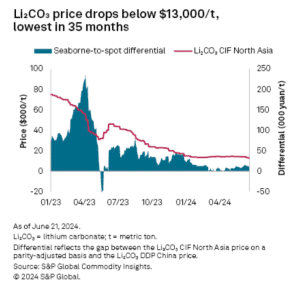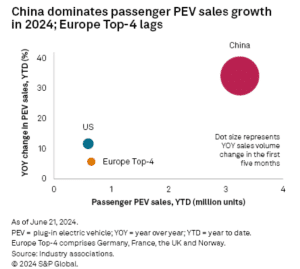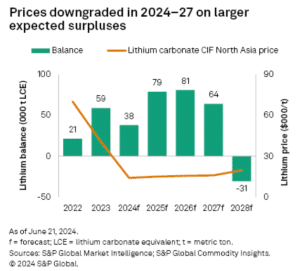Lithium prices plunged below $13,000/ton in June 2024, the lowest in 35 months, according to S&P Global Commodity Insights data. This is despite plug-in electric vehicle (PEV) sales across major markets have surged for the first 5 months.
Lithium Prices Hit New Lows
Lithium is the key element in manufacturing electric vehicles. Though lithium prices saw a slight increase in March, they declined in June 2024, driven by anticipated reductions in downstream battery production. The seaborne lithium carbonate CIF Asia price fell to a 35-month low of $12,900 per ton by June 18.
Source: S&P Global
Similarly, spodumene prices dropped by 9.5% to $1,050 per pound FOB-Australia, causing the merchant conversion margin to turn negative, averaging minus $118 per ton in June from $7,027 per ton in May.
Further decreases in spodumene prices are needed to prompt new mine-side supply cuts, last seen when prices fell below $900 per ton between mid-January and end-February.
Despite low prices, government interest in securing lithium production remains strong. Indonesia is emerging as a significant player in lithium chemicals production, integrating raw material-to-PEV supply chains. Chengxin started trial lithium chemical production in Indonesia in June, following the shipment of the first spodumene cargo from Port Hedland to Indonesia in May.
Additionally, the Serbian government is considering greenlighting the Jadar lithium project by Rio Tinto, which was previously halted in January 2022. This project would be Europe’s largest integrated lithium mine-to-refinery operation. It has a capacity of 58,000 metric tons of lithium carbonate, helping meet the EU’s battery metals demand.
And it’s not the EU, the rest of the world is vying for lithium as the global economy is ramping up electrification in transport.
Government Initiatives and Global Lithium Demand
In May 2024, PEV sales across key markets increased by 14.7% month-over-month and 25.9% year-over-year for the first five months, per S&P Global report.
China dominated, contributing nearly 90% of this growth, buoyed by new model launches and price discounts. Conversely, Germany and Norway saw declining sales, negatively impacting Europe’s top markets.
Source: S&P Global
In Europe and the US, PEV adoption is stalling due to the higher costs of battery electric vehicles (BEVs) despite brand discounts. Germany’s BEV sales dropped by 15.9% year-over-year after the environmental bonus ended in December 2023. BEV sales in the UK comprised 16% of total car sales but missed the 22% target under the 2024 zero-emissions vehicle mandate.
In the US, PEV sales have remained at 8%-10% of vehicle sales in 2024, consistent with late 2023 levels. More affordable models, especially in the $20,000 range, are needed to boost uptake in these markets.
From July 4, the EU will impose tariffs on imported BEVs from China, increasing up to 48.1% from the current 10%. The bloc aims to protect the European automotive industry and encourage local BEV production. However, this move might hinder the EV transition.
Between 2020 and 2023, BEV imports from China to the EU rose sevenfold. They’ve reached over 437,800 units in 2023, representing 28% of the 1.5 million BEVs sold in the bloc. These imports contained significant amounts of lithium carbonate equivalent (21,300 metric tons).
Accordingly, the EV revolution hinges on how the lithium market is moving forward and its forecasts.
Future Outlook for Lithium Market
Lithium prices have not shown signs of sustained recovery as the first half of 2024 ends. China’s reserve-buying of cobalt metal in May provided only short-lived support. Prices reached new multi-year lows in June due to summer’s downturn in battery demand and growing supply.
So, what’s in store for lithium in the coming months and years?
According to S&P Global lithium market outlook, prolonged low lithium carbonate prices are likely to pressure spodumene prices, potentially leading to further mine supply cuts and project delays.
Despite strong copper prices supporting cobalt by production and growing mine-side inventory, reduced consumer demand for PEVs has prompted many manufacturers to slow their EV targets and cancel new battery plants, like BMW’s €2 billion contract with Northvolt AB.
Higher import tariffs on China-made BEVs could slow EV transition in the EU and the US by making vehicles more expensive. The outcome of EU-China trade negotiations is crucial, as Europe balances relations with China and the US. The latter’s tax credits and funding attracting investments away from Europe, which is still building its support system.
Market surpluses for lithium would be larger in 2024, with forecasts of 38,000 metric tons LCE. Consequently, the lithium carbonate CIF Asia price forecast has been downgraded by $290/t to $14,129/t.
Source: S&P Global
A seasonal recovery in PEV sales is expected from September through year-end, which could narrow market surpluses and support prices. The long-term outlook for PEV uptake remains positive as automakers launch more affordable vehicles in the $20,000 range.
The future of the lithium market remains uncertain, with potential for further supply cuts and project delays. However, the long-term outlook for PEV uptake remains positive as automakers launch more affordable vehicles, potentially narrowing market surpluses and supporting prices.




